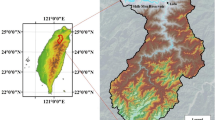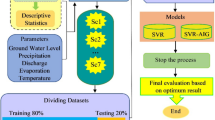Abstract
One of the management strategies of water resources systems is the combination of simulation and optimization models to achieve the optimal policies of reservoir operation in the form of specific optimization. This study utilizes an integration of the NSGA-II multi-objective algorithm and WEAP simulator model so that the first objective is to maximize the reliability of providing the needs in front of the second goal, i.e., to minimize the drawdown the water table at the end of the operation time. The dam rule curve or the amount of released volume from the reservoir is optimized to supply downstream uses in these conditions. However, in certain optimizations, the optimal solutions cannot be generalized to other possible inputs to the reservoir, and if the inflow to the reservoirs changes, the obtained optimal solutions are no longer efficient and the system must be re-optimized in the form of an optimizer algorithm. Therefore, to solve this problem, a new method is extended on the basis of the combination of the support vector machine and NSGA-II algorithm for optimal real-time operation of the system. The results demonstrate that the average error rate of optimal rules derived from support vector machines is less than 2.5% compared to the output of the NSGA-II algorithm in the verification step, which indicates the efficiency of this method in predicting the optimal pattern of the dam rule curve in real time. In this structure, based on the inflow to the reservoir, the volume of water storage in the reservoir and changes in the reservoir storage (at the beginning of the month) and the downstream demands of the current month, the optimal release amount can be achieved in real time. Therefore, the developed support vector machine has the ability to provide optimal operation policies based on new data of the inflow to the dam in a way that allows us optimally manage the system in real time.








Similar content being viewed by others
Explore related subjects
Discover the latest articles and news from researchers in related subjects, suggested using machine learning.Data availability
The datasets used and/or analyzed during the current study are available from the corresponding author on reasonable request.
References
Azari A, Hamzeh S, Naderi S (2018) Multi-objective optimization of the reservoir system operation by using the hedging policy. Water Resour Manage 32(6):2061–2078. https://doi.org/10.1007/s11269-018-1917-5
Babamiri O, Azari A, Marofi S (2022) An integrated fuzzy optimization and simulation method for optimal quality-quantity operation of a reservoir-river system. Water Supply 22(4):4207–4229. https://doi.org/10.2166/ws.2022.045
Bayesteh M, Azari A (2021) Stochastic optimization of reservoir operation by applying hedging rules. J Water Resour Plan Manag 147(2):04020099. https://doi.org/10.1061/(ASCE)WR.1943-5452.0001312
Blum C, Roli A (2003) Metaheuristics in combinational optimization: overview and conceptual comparision. ACM Comput Surv 35(3):268–308
Candela JQ, Hansen LK (2002) Time series prediction based on the Relevance Vector Machine with adaptive kernels. IEEE Int Conf Acoust, Speech, and Signal Process 1:I-985-I-988
Chang JF, Chen L, Chang CL (2005) Optimizing reservoir operating rule curves by genetic algorithms. Hydrol Process 19:2277–2289
Deb K, Pratap A, Agarwal S, Meyarivan T (2002) A fast and elitist multi-objective genetic algorithm: NSGA-II. IEEE Trans Evol Comput, Indian 6(2):182–197
Du J, Liu Y, Yu Y, Yan W (2017) A prediction of precipitation data based on support vector machine and particle swarm optimization (PSO-SVM) algorithms. Algorithms 10(57):1–15
Goorani Z, Shabanlou S (2021) Multi-objective optimization of quantitative-qualitative operation of water resources systems with approach of supplying environmental demands of Shadegan Wetland. J Environ Manage 292(6):112769. https://doi.org/10.1016/j.jenvman.2021.112769
Jalilian A, Heydari M, Azari A, Shabanlou S (2022) Multi-objective optimization of the reservoir system operation by using the hedging policy. water resources. Management 36(6):1763–1782. https://doi.org/10.1007/s11269-022-03087-3
Jian C, Qiang H, Min W (2005) Genetic algorithm for optimal dispatchin. Water Resour Plan Manag 19:321–331
Kalita HM, Sarma AK, Bhattacharjya PK (2014) Evaluation of optimal river training work using GA based linked simulation-optimization approach. Water Resour Manag 28:2077–2092. https://doi.org/10.1007/s11269-014-0593-3
Lei J, Quan Q, Li P, Yan D (2021) Research on monthly precipitation prediction based on the least square support vector machine with multi-factor integration. Atmosphere 12(8):1076. https://doi.org/10.3390/atmos12081076
Lin JY, Cheng CT, Chau KW (2006) Using support vector machines for long-term discharge prediction. Hydrol Sci-J-Des Sci Hydrologiques 51(4):599–612
Momtahen Sh, Dariane AB (2007) Direct search approaches using genetic algorithms for optimization of water reservoir operating policies. Water Resour Plan Manag, ASCE 133(3):202–209
Nicklow J, Reed P, Savic D, Dessalegne T, Harrell L, Chan-Hilton A, Karamouz M, Minsker B, Ostfeld A, Singh A, Zechman E (2010) State of the art for genetic algorithms and beyond in water resources planning and management. J Water Resour Plan Manag 136:412–432. https://doi.org/10.1061/(ASCE)WR.1943-5452.0000053
Su J, Wang X, Liang Y, Chen B (2014) GA-based support vector machine model for the prediction of monthly reservoir storage. J Hydrol Eng 19(7):1430–1437. https://doi.org/10.1061/(ASCE)HE.1943-5584.0000915
Tennant DL (1976b) Instream flow regimens for fish, wildlife, recreation and related environmental resources. Fisheries 1(4):6–10
Thissen U, van Brakel R, de Weijer AP, Melssen WJ, Buydens LMC (2003) Using support vector machines for time series prediction. Chemom Intell Lab Syst 69:35–49
Wardlaw R, Sharif M (1999) Evaluation of genetic algorithms for optimal reservoir system operation. Water Resour Plan Manag, ASCE 125(1):25–33
Wu J, Guo S, Huang H, Liu W, Xiang Y (2018) Information and communications technologies for sustainable development goals: state-of-the-art, needs and perspectives. IEEE Commun Surv Tutor 20(3):2389–2406. https://doi.org/10.1109/COMST.2018.2812301
Wu J, Guo S, Li J, Zeng D (2016) Big data meet green challenges: big data toward green applications. IEEE Syst J 10(3):888–900. https://doi.org/10.1109/JSYST.2016.2550530
Xi XC, Poo AN, Cho SK (2007) Support vector regression model predictive control on a HVAC plant. Control Eng Pract 15:897–908
Zeinali M, Azari A, Heidari M (2020) Multiobjective optimization for water resource management in low-flow areas based on a coupled surface water–groundwater model. J Water Resour Plan Manag (ASCE) 146(5):04020020. https://doi.org/10.1061/(ASCE)WR.1943-5452.0001189
Author information
Authors and Affiliations
Contributions
All authors (Ahmad Aman Jalili, Mohsen Najarchi, Saeid Shabanlou, Reza Jafarinia) have an equal share in writing all parts of the article.
Corresponding author
Ethics declarations
Ethics approval and consent to participate
Not applicable.
Consent for publication
Not applicable.
Conflict of interest
The authors declare no competing interests.
Additional information
Responsible Editor: Marcus Schulz
Publisher's note
Springer Nature remains neutral with regard to jurisdictional claims in published maps and institutional affiliations.
Rights and permissions
Springer Nature or its licensor holds exclusive rights to this article under a publishing agreement with the author(s) or other rightsholder(s); author self-archiving of the accepted manuscript version of this article is solely governed by the terms of such publishing agreement and applicable law.
About this article
Cite this article
Jalili, A.A., Najarchi, M., Shabanlou, S. et al. Multi-objective Optimization of water resources in real time based on integration of NSGA-II and support vector machines. Environ Sci Pollut Res 30, 16464–16475 (2023). https://doi.org/10.1007/s11356-022-22723-4
Received:
Accepted:
Published:
Issue Date:
DOI: https://doi.org/10.1007/s11356-022-22723-4




